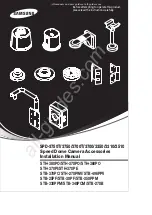
Page 20
Installation
optoNCDT 1220
5.1.2
Error Influences
5.1.2.1
Light from other Sources
Thanks to their integrated optical interference filters the optoNCDT 1220 sensors offer outstanding perfor-
mance in suppressing light from other sources. However, this does not preclude the possibility of interference
from other light sources if the objects being measured are shiny and if lower measuring rates are selected.
Should this be the case it is recommended to use suitable shields to screen the other light sources. This ap-
plies in particular to measurement work performed in close proximity to welding equipment.
5.1.2.2
Color Differences
Because of intensity compensation, color difference of targets affect the measuring result only slightly. How-
ever, such color differences are often combined with different penetration depths of the laser light into the
material. Different penetration depths then result in apparent changes of the measuring spot size. Therefore
color differences in combination with changes of penetration depth may lead to measuring errors.
5.1.2.3
Temperature Influences
When the sensor is commissioned a warm-up time of at least 20 minutes is required to achieve uniform
temperature distribution in the sensor. If measurement is performed in the micron accuracy range, the effect
of temperature fluctuations on the sensor holder must be considered. Due to the damping effect of the heat
capacity of the sensor, sudden temperature changes are only measured with delay.
5.1.2.4
Mechanical Vibration
If the sensor is to be used for resolutions in the µm to sub-µm range, special care must be taken to ensure
stable and vibration-free mounting of sensor and target.
5.1.2.5
Movement Blurs
If the objects being measured are fast moving and the measuring rate is low, it is possible that movement
blurs may result. Always select a high measuring rate for high-speed operations, therefore, in order to prevent
errors.
Содержание ILD 1220-10
Страница 8: ...optoNCDT 2300...
Страница 93: ......
















































